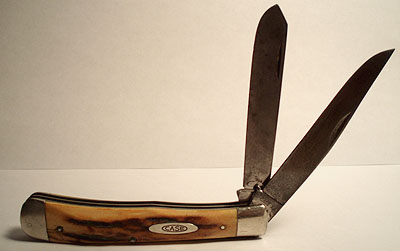Needing another break from the ongoing transcribing “process,” I turn to a relic that’s never been too far from my desktop since the late 1980s. It’s one of two things I cherish from my predominately uncherishable stepfather Bill Cox — neither of them officially bequeathed to me after his 1988 death so much as just unofficially kept.
The first is far more historic in sports circles: a game ball from the 1930 Rose Bowl game, presented by USC to Buster Keaton and signed by the team that trounced Pitt 47-14. Keaton and my stepdad were friends and I’m guessing. Owing to Keaton and Cox not caring for the ball very well it’s in pretty sad shape. Various tains and scratches and just good old age mar the players’ signatures and other decorations inked on it some 76 years ago when it was presented to Keaton.
But it’s the second item that’s the object of my distracted attention. It’s nothing really, just a two-bladed Case knife whose handle is made from some unknown material:

It’s the knife Cox kept at his desk up until he died and I’ve kept it at mine since then. Not that I used it for all that much, but with it close at hand and ample the occasions to get distracted from the task at hand (such as the painfully laborious one today), time and again I’ve pulled it out of the pen cup where it resides with other mostly unused obects of my past such as my letter opener and pica pole and pondered about its age and materials and such. Since Cox was 87 when he died I was always curious as to whether I was the keeper of some century-old blade that he might have had since his youth.
Well, not quite. Thanks to the markings and stamps on the blade hilts and the magic of the internet — specifically Case Knives’ excellent website — I discovered the truth of the matter. First I found out from the pattern stamp that reads “5254” that the first “5” stands for the handle’s material, which is “genuine stag” (whether that’s bone or antler I don’t know). The “2” after it indicates the number of blades the knife has and the last two numbers show it to be in the “Trapper” pattern.
And it’s age? Well, that mystery’s solved as well. The logo style on the pointy blade’s hilt (Case calls it the “tang”), which reads like this:
CASE XX
U.S.A.
Signifies the knife’s anywhere from a year to 16 years younger than me, manufactured somewhere between 1965 and 1980.
So much for another piece of history. And so much for me trying to avoid returning to my duties.
 Follow
Follow